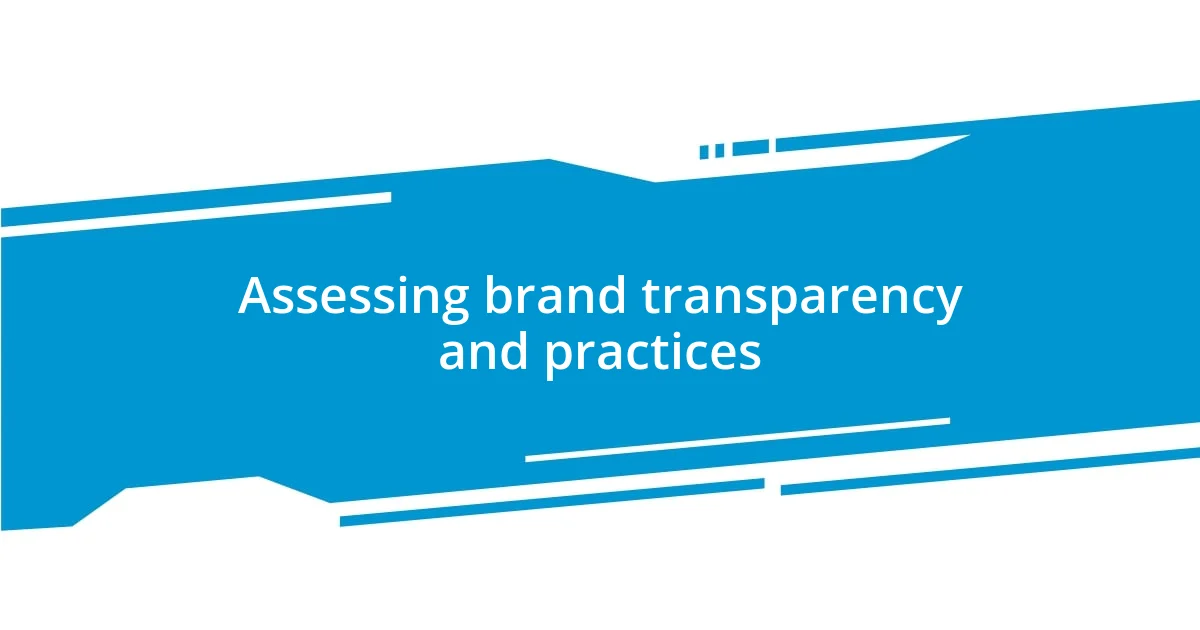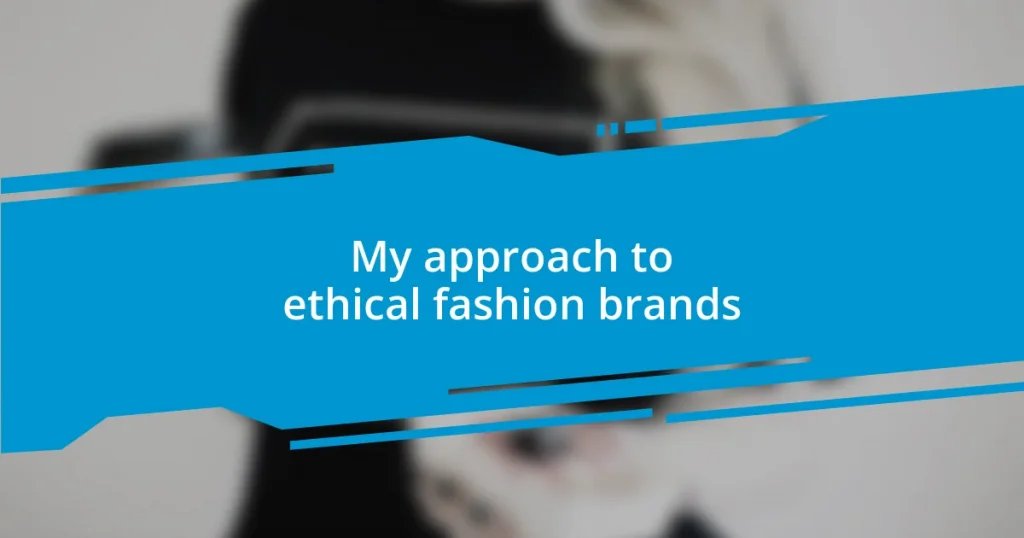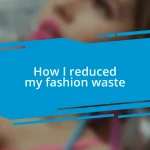Key takeaways:
- Ethical fashion emphasizes sustainability, transparency, and fair labor practices, transforming shopping into a conscious decision-making experience.
- Certifications like Fair Trade and GOTS assure consumers of a brand’s commitment to ethical principles, making informed purchasing decisions easier.
- Engaging with the ethical fashion community enhances consumer knowledge, revealing the importance of true sustainability versus marketing claims.

Understanding ethical fashion brands
Ethical fashion brands prioritize sustainability and social responsibility in their production processes. Reflecting on my own experience, I recall the excitement I felt when I discovered a brand that not only made beautiful clothes but also sourced materials responsibly and treated workers fairly. It made me realize that every purchase I make can echo my values.
When you think about ethical fashion, it’s crucial to immerse yourself in the story behind the garments. Have you ever wondered about the journey your clothes undertake before they reach your closet? For me, understanding the ethics behind a brand transformed my shopping experience from mere consumption to conscious decision-making, making every piece feel special and meaningful.
There’s a certain warmth in supporting companies that genuinely care about the planet and its people. I often find myself gravitating toward brands whose stories resonate with my beliefs, knowing that my choices contribute to a larger positive impact. Isn’t it fulfilling to wear something that feels like part of a greater change?

Key principles of ethical fashion
Ethical fashion hinges on transparency. When I engage with a brand, I appreciate knowing where materials come from and how workers are treated. It gives me peace of mind, like a quiet reassurance that my choices are aligned with my values. Isn’t it comforting to think that every stitch tells a story of integrity?
Another vital principle is sustainability. I vividly remember the first time I learned about clothing’s environmental impact. It was startling! I realized how much waste fast fashion generates. Now, I opt for brands that use eco-friendly materials and sustainable practices. It feels good to wear something that doesn’t harm the planet but it also sparks a conversation about environmental stewardship.
Lastly, fair labor practices matter immensely in ethical fashion. Supporting brands that ensure fair wages and safe working conditions is a non-negotiable for me. It strikes me as a moral imperative. I think of the workers behind the seams, and by choosing ethical brands, I feel like I’m not just a consumer but an ally in this ongoing movement for justice and dignity in the industry.
| Principle | Description |
|---|---|
| Transparency | Understanding the sourcing and production processes of garments. |
| Sustainability | Using eco-friendly materials and practices to reduce environmental impact. |
| Fair Labor Practices | Ensuring workers are paid fairly and work in safe conditions. |

Identifying certified ethical brands
Identifying certified ethical brands can feel daunting at first, but I’ve learned to look for specific certifications that genuinely reflect a brand’s commitment to ethical practices. When I stumbled upon my first ethically certified piece, the emblem on the tag felt like a conversation starter – it was my way of connecting with a brand that aligned with my values. Certifications like Fair Trade, Global Organic Textile Standard (GOTS), and B Corp resonate with me as they confirm that the brand undergoes rigorous evaluations.
Here are some certifications to keep an eye out for when seeking ethical brands:
- Fair Trade: Ensures fair wages and safe working conditions for workers.
- Global Organic Textile Standard (GOTS): Certifies organic fibers and environmentally friendly processes throughout production.
- B Corp: Recognizes companies that meet high social and environmental performance standards.
- OEKO-TEX: Verifies that textiles are free from harmful substances and safe for human use.
In my journey toward ethical shopping, I’ve discovered that being informed can empower my choices. When examining a brand, I also pay attention to their transparency about the supply chain. A brand that openly shares its sources and practices not only gains my trust but becomes my ally in promoting positive change. Just the other day, I found myself staring at a label that didn’t just boast about eco-friendliness but also detailed where its materials were sourced. It felt like unlocking a treasure chest of values, making my purchase feel even more gratifying.

Evaluating sustainable materials used
When I dive into a brand’s material choices, I’m always intrigued by natural fibers like organic cotton, linen, and Tencel. These materials are not only biodegradable but also require fewer chemicals in their production. I once purchased a dress made from Tencel, and it felt like wearing a cloud—so soft and breathable! It made me wonder how often we overlook the sensory pleasures that sustainable materials can offer.
Recycled materials also catch my eye, particularly when they come from post-consumer waste, like plastic bottles. It’s fascinating to think that something once discarded can be transformed into a chic piece of clothing. Recently, I found a stylish bag made from recycled ocean plastic, and every time I use it, I feel like I’m participating in a larger movement against pollution. Doesn’t that add another layer of meaning to what we wear?
Another aspect I consider is the transparency of sourcing. Brands that can trace their materials back to their origins demonstrate a commitment to ethical fashion that resonates with me. I recall reading about a company that not only sourced organic hemp but also provided stories of the farmers who grew it. It made my purchase feel connected to real people. Isn’t it incredible how knowing the story behind our clothing can deepen our appreciation for it?

Assessing brand transparency and practices
When assessing a brand’s transparency, I’ve learned to dig deep into their storytelling. A brand that takes the time to share its journey resonates with me; it’s like they’re inviting me into their world. I remember discovering a small label that not only showcased its manufacturing process on its website but also highlighted the stories of its artisans. How refreshing it felt to connect with the makers behind the products! This level of openness gives me confidence that the brand values ethical practices.
Transparency isn’t just about sharing the good parts; it’s also about addressing challenges. I find it intriguing when brands acknowledge their struggles with sustainability. For instance, one brand I admire openly discussed its issues with sourcing ethical dyes and how it’s working to overcome them. This vulnerability fosters a sense of authenticity. It made me reflect—shouldn’t we all feel empowered when brands demonstrate their commitment to growth and improvement, rather than presenting a polished, perfect image?
I often keep an eye out for detailed product information. The specifics around a brand’s supply chain practices can make all the difference for me. I once stumbled upon a fashion company that not only outlined its suppliers but also used video content to show its factories. Watching those clips sparked a connection; I felt part of the community that appreciates not just fashion, but the people behind it. Isn’t it amazing how transparency can bridge the gap between consumers and creators, sparking a deeper appreciation for our choices?

Making informed purchasing decisions
When making informed purchasing decisions, I often turn to the potential impact of my choices on both the environment and the communities involved. For example, I remember a time when I hesitated before buying a trendy jacket. After some research, I found out that the brand prioritized fair labor practices and utilized environmentally friendly production methods. That knowledge instantly made the jacket more appealing, transforming a simple purchase into a step toward supporting ethical fashion.
Additionally, I’m drawn to certifications and labels that can guide my purchases. It’s always satisfying to spot a brand that carries a well-known sustainability certification. I once came across a pair of shoes that bore the Fair Trade logo, and it felt like I wasn’t just adding a stylish item to my closet, but also supporting better living conditions for workers. Have you ever felt a rush of excitement knowing your purchase is making a positive impact? It’s that connection that keeps me engaged in the ethical fashion conversation.
Lastly, I find that engaging with communities and discussions around ethical fashion enhances my understanding. I often visit forums and social media groups dedicated to sustainable fashion, where people share their experiences and insights. I vividly recall a discussion that opened my eyes to how certain brands market themselves as sustainable without truly embracing those values. Such conversations empower me to be a more savvy consumer, as I learn from others’ discoveries and missteps. Isn’t it fascinating how shared knowledge can reshape our views and choices in fashion?















